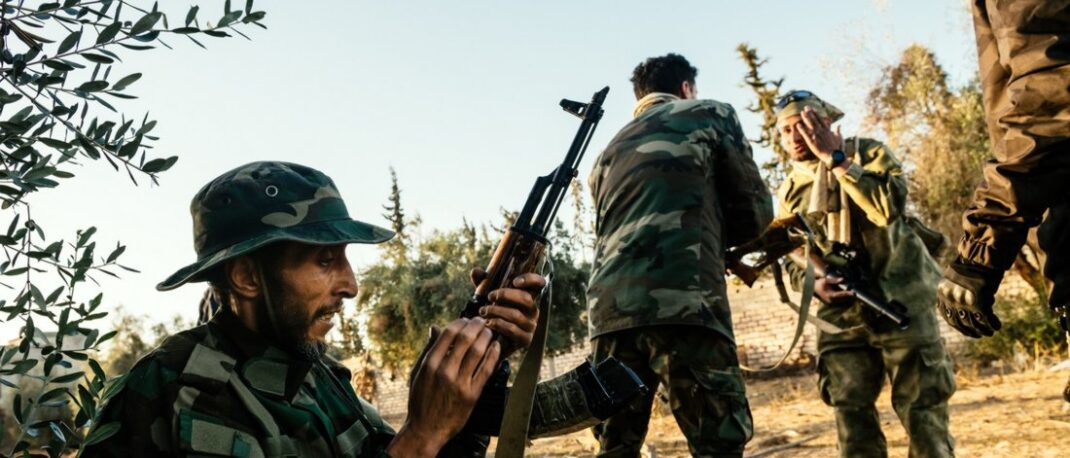Emadeddin Badi
 The transformations witnessed in Libya’s security sector over the past decade largely reflect the violence that reshaped the country’s social landscape during the 2011 revolution.
The transformations witnessed in Libya’s security sector over the past decade largely reflect the violence that reshaped the country’s social landscape during the 2011 revolution.
Gaddafi, formerly the lynchpin to an idiosyncratic distributive state built on coercion and patronage, bequeathed post-revolutionary Libya with hollowed-out institutions, a rentier economic system, and a zero-sum political culture.
His demise was the culmination of a multiplicity of local uprisings that effectively devolved power from his own hands to those of the revolutionaries that overthrew him. However, while his monopoly on violence effectively disintegrated, his state’s other dysfunctional features and its patronage structures were preserved – either deliberately or inadvertently.
The scramble to monopolize Gaddafi’s state’s levers laid the foundation for many of the fault lines – and subsequent conflicts – that further reshaped Libya’s security sector after his downfall.
Nevertheless, while the splintering of Libya’s security sector after 2011 can be argued to have initially mirrored the fragmentation of Libya’s political scene, today, many armed groups have effectively become their own political actors.
The evolution of Libyan armed groups’ relationships with political institutions has significantly evolved overtime. The contemporary reality – with different typologies of hybrid security actors that defy the Weberian-influenced dichotomies of formal and informal – is anchored in the revolution’s diverging patterns across Libyan locales.
Endowed with a sense of entitlement after overthrowing Gaddafi, disparate groups of revolutionaries coalesced into ad-hoc parallel structures through which they effectively sought to replace or contend with possible remnants of Gaddafi-era security structures in their local areas of control.
Riding on a short-lived wave of post-revolutionary euphoria and a dose of policy myopia, Libya’s transitional authorities opted to bankroll these new structures by deputizing them to provide security, bestowing legitimacy upon them by way of state affiliation.
The fateful decision was concomitant with the burgeoning of rogue militias – formed by young Libyans that had not fought in the revolution but saw in its aftermath an opportunity to reap financial gains.
The policy of attempted co-option conflated both revolutionary and rogue groups, marking the advent of security pluralism as the first phase of transmutation in Libya’s security landscape.
The second turning point that morphed the nature of Libyan armed groups’ relationship with political institutions was the by-product of a combination of intra-elite divisions and armed groups’ desire to sustain legitimacy and support from their communities.
Rife with tensions underpinned by tribal, geographic, ethnic, or ideological divides, the socio-political and economic landscapes of the time enabled this transformation.
Some armed groups had begun manoeuvring to secure their own sources of income outside of the state’s control – often leveraging the political and communal mantles of legitimacy at their disposal to operationalize these rent-seeking efforts. Politicians – backed by regional powers – sponsored competing integration processes, often purposefully pitting Gaddafi-era armed structures as well as post-revolutionary armed groups against one another.
While some revolutionaries shunned any integration efforts that they perceived as antithetic with their revolutionary creed, others wilfully integrated into what some regarded as remnants of Gaddafi’s formal security apparatuses.
The latter had suffered from a depletion in human capital due to the regime-era cadre’s marginalization and desertion, leaving hollow structures that were subsequently overstaffed.
Overall, Libya’s political elite’s clumsy competition, coupled with the jockeying of armed groups over legitimacy, exacerbated the security landscape’s hybrid nature, compounding it with another layer of informality.
Post-2014, the relationships of armed groups with political institutions experienced a reconfiguration. The eruption of a civil war in mid-2014 – largely the aforementioned dynamics’ culmination – ended the country’s transitional process and bifurcated its institutions.
Despite negotiations under the United Nations’ aegis leading up to an agreement to form an internationally recognized transitional government, the institutional schism persisted.
Armed groups leveraged the progressive decline of these truncated entities’ legitimacy, along with their own de-facto power on the ground, to entrench and predate over state revenues.
This transition further enabled expedient proxy dynamics that saw international actors favour engaging armed actors over civilian state authorities.
Foreign powers unilaterally engaged those that were most capable of addressing their perceived security imperatives (be they migration or counterterrorism related), while other regional states empowered those that could drive their ideological geopolitical agendas forward.
The opportunity-cost of these predominantly covert partnerships were that some allegedly criminal armed groups were empowered into semi-formality at the expense of state sovereignty.
This dynamic not only emboldened these armed groups into developing a pernicious war economy but also enabled them to infiltrate the state to capture its levers with their very own nomenklatura.
If binaries’ appositeness centered around state versus non-state, or formal and informal, to these armed actors were questionable before this period, they became entirely irrelevant thereafter.
Today, reforming Libya’s security sector is contingent upon coming to terms with the various dynamics that induced– or were the result of – the transmutation of its security infrastructure over time. More importantly, it also entails recognizing that some of Libya’s hybrid armed actors have become their very own political actors.
Therefore, they are able to manoeuvre their way into entrenchment by leveraging revenue-generation, proxy backing, politicking, territorial control, violence, or their various social ties.
Acknowledging this would allow for the development of iterative design processes that adapt some of the traditionally rigid doctrines upon which security sector reform (SSR) efforts are premised.
More broadly, this more informed and realistic conceptualization of hybrid armed actors’ networks and breadth of influence would allow policymakers to avoid the common pitfall of approaching security arrangements and reform in a silo.
It would also factor in that their affiliation with state institutions is often pro-forma, and matters only to the armed groups in question insofar as they are able to instrumentalize it to retain influence.
More broadly, while SSR’s technical aspects should indeed be diligently planned and implemented, recognizing the inter-dependency of the security, political, economic, and community-centred dimensions of Libya’s post-conflict mediation processes is part and parcel of devising an operable and chronologically coherent SSR blueprint.
Only then would there be a true reckoning with the country’s hybrid security landscape.
***
Emadeddin Badi is an Advisor for Libya at DCAF – Geneva Centre for Security Sector Governance, Senior Analyst at the Global Initiative Against Transnational Organized Crime, and Non-Resident Senior Fellow at the Atlantic Council’s Middle East Program. The opinions expressed in this article are those of the author alone and do not necessarily reflect the position of the institutions he is affiliated to.
___________





